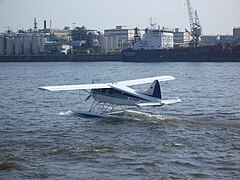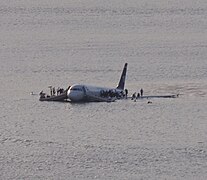Wasserung
Wasserung ist die Landung mit einem Wasserflugzeug, Flugboot oder Raumfahrzeug auf einem Ozean, Fluss oder See. Eine Notlandung normaler Flugzeuge auf einer Wasseroberfläche wird als „Notwasserung“ bezeichnet.
In den ersten zwei Jahrzehnten der bemannten Raumfahrt landeten insbesondere US-amerikanische Raumfahrzeuge auf dem Wasser im Pazifik oder Atlantik und wurden dann von Helikoptern geborgen. Dabei handelte es sich um die Raumschiffe des Mercury-, Gemini- und Apollo-Programms.
Das Verfahren wurde in jüngerer Zeit wiederbelebt: Die von dem Privatunternehmen SpaceX gestartete Raumfähre Dragon wasserte erstmals am 8. Dezember 2010 im Pazifischen Ozean.[1] Auch das Orion-Raumschiff des Artemis-Mondprogramms kehrt per Wasserung auf die Erde zurück.
- Wasserung eines Apollo-Kommandomoduls
(August 1971) - Die US-Astronauten Neil Armstrong und David Scott im Raumschiff Gemini 8 nach ihrer Wasserung im Pazifik im März 1966
- Notwasserung von US-Airways-Flug 1549 im Hudson River bei New York City
(Januar 2009) - Wasserung einer Sikorsky HH-3F Pelican der US-Küstenwache auf dem Meer bei einem brennenden Boot
Siehe auch
Weblinks
Einzelnachweise
- ↑ Klaus Donath: SpaceX Dragon-Kapsel startet und wassert erfolgreich. raumfahrer.net, 8. Dezember 2010, abgerufen am 9. Dezember 2010.
Auf dieser Seite verwendete Medien
Apollo 15 Command Module splashdown.
The Apollo 15 Command Module (CM), with astronauts David R. Scott, commander; Alfred M. Worden, command module pilot; and James B. Irwin, lunar module pilot, aboard safely touches down in the mid-Pacific Ocean to conclude a highly successful lunar landing mission. Although causing no harm to the crew men, one of the three main parachutes failed to function properly. The splashdown occurred at 3:45:53 p.m. (CDT), Aug. 7, 1971, some 330 miles north of Honolulu, Hawaii. The three astronauts were picked up by helicopter and flown to the prime recovery ship, USS Okinawa, which was only 6 1/2 miles away.
USCG HH-3F Pelican on the water, illustrating the Pelican's amphibious capability.
Autor/Urheber: de:Benutzer:Gulp, Lizenz: CC BY-SA 3.0
Inzwischen abgestürztes Wasserflugzeug im Hamburger Hafen / Seaplane in Hamburg
Astronauts Neil A. Armstrong (right) and David R. Scott (left) sit with their spacecraft hatches open while awaiting the arrival of the recovery ship, the USS Leonard F. Mason after the successful completion of their Gemini VIII mission. They are assisted by U.S. Air Force Pararescuemen, who jumped to their spacecraft. The Pararescuemen are: A/2C Glenn M. Moore (by the hatch), A/1C Eldridge M. Neal (upper left); and S/Sgt Larry D. Huyett (center standing on the floatation collar). The overhead view shows the Gemini 8 spacecraft with the yellow flotation collar attached to stabilize the spacecraft in choppy seas. The green marker dye is highly visible from the air and is used as a locating aid.
Autor/Urheber: Greg L, Lizenz: CC BY 2.0
Photo of US Airways Flight 1549 after crashing into the Hudson River in New York City, United States.









